Growth period of cannabis (Vegetative growth)
List of contents
Of the three stages of development that a cannabis plant has from seed - germination, growth and flowering, the second stage, vegetative growth, may seem the least demanding or important. This would be a big mistake, as each phase is integral to the whole process and neglecting or not properly caring for the crop during any one of them will have a negative impact on what remains of the plant’s development. So the vegetative or growth phase of cannabis is equally as important as germination or flowering.
What we call the growth or vegetative phase is the period of the plant’s development that starts when the seed has germinated and lasts until the plant begins to bloom. In this phase the plant shows exponential growth; the more vegetable mass, leaves and branches develop, the faster the growth accelerates, generating in turn more leaves and more branches.
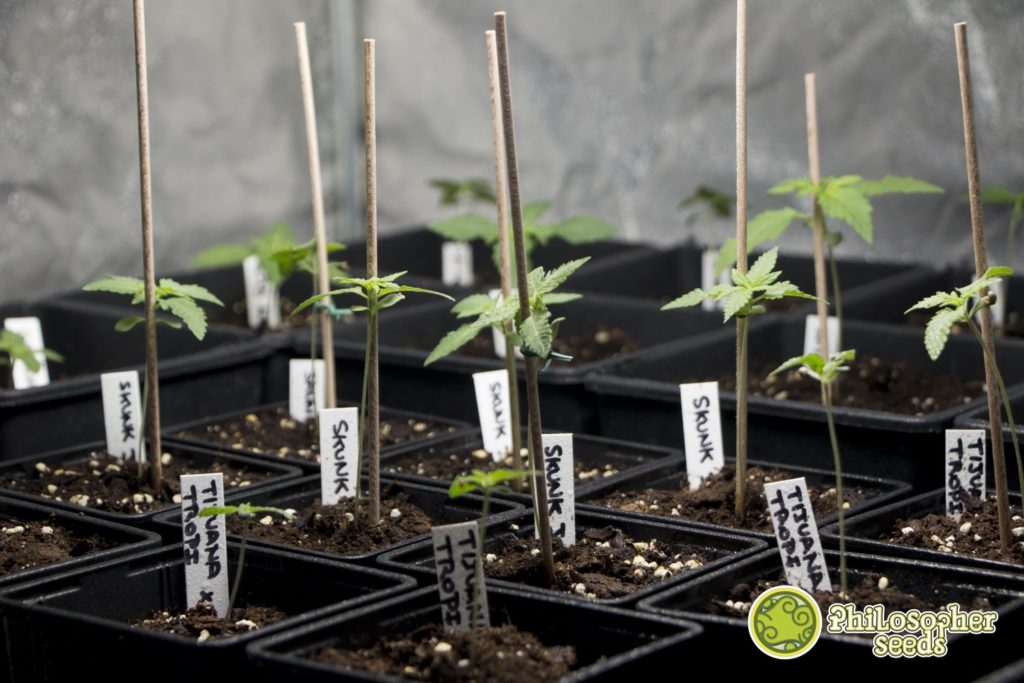
There are several factors that influence the vegetative phase of cannabis plants. There is no doubt that the future of our plants depends upon our knowledge of these factors, and the way in which we cope with them will have a direct consequence on whether we successfully harvest our plants or not.
Indoor Growing/Outdoor Growing
The only difference between outdoor cultivation and indoor cultivation of cannabis in terms of the growth phase of marijuana between outdoor cultivation and indoor cultivation is basically the light source, which outdoors is natural (the Sun), and indoors is artificial (lights HM, LEC, Fluorescent and CFL or LED systems).
When cultivating outdoors we are governed by the seasons, waiting to grow during the time of year with favorable photoperiod and temperature conditions. Therefore, light and temperature are out of our hands in outdoor cultivation since there is little we can do to control these factors, and if we do so it will be in a very indirect way. So to avoid problems, there is usually one outdoor crop per year which in the northern hemisphere will approximately be from April to October and in the southern hemisphere from September to May.
All that remains is for us to focus on factors such as the growing medium, irrigation and nutrients, elements that act in much the same way as they do in an indoor grow. So we will define these points below and the explanations will serve us for both types of grow, always following the necessary specifications.
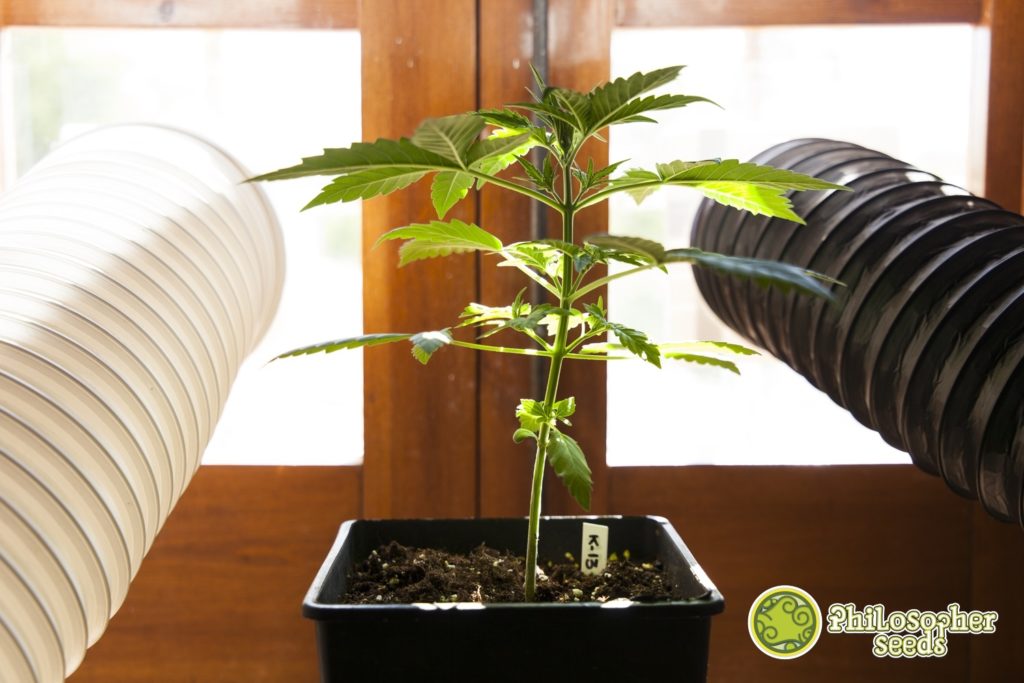
We should point out that in outdoor cultivation the growth phase is of considerably longer duration than indoors as we can not alter the photoperiod the plants receive. If we begin the grow in spring, the growth phase can last 3-4 months for the earliest varieties, while that of the later ones can last up to 5-6 months.
Growing indoors, however, is another world completely, as all the variables are in play, and we are able to manipulate some of the natural processes of the plant, such as accelerating its development or achieving better results in terms of flavour, effect and yield. To make these improvements, a proper development of the growth phase is necessary.
The vegetative phase of indoor cannabis plants will almost always be shorter than outdoors, although it can vary greatly depending on the variety or type of plant we grow and how we do it. There’s a big difference between cultivating an autoflowering variety, where the growth period lasts from 2-4 weeks, and growing feminized seeds for which this period can last from 4 to 8 weeks depending on the variety and the other factors.
Growing medium
The growing medium that we use will also influence the duration of the growth phase. The growth period last a bit longer if we use soil, although it’s also the growing medium that’s the easiest to control, so it’s ideal for novice growers. With a substrate that is rich in nutrients, or with a good soil mix with solid fertilisers, you can perfectly cover the nutritional needs of the plant throughout the growth phase.
When cultivating in coconut fibre the growth period is usually shorter, mainly because in the early stages of growth the coco fibre provides optimum oxygenation to the roots, with an explosion development in the plant due to the improved growth of the root system. Coco fibre is a more demanding culture medium for the grower, in particular with the control of watering and nutrient application (adjustment of pH and EC, temperature and oxygenation of the nutrient solution, etc).
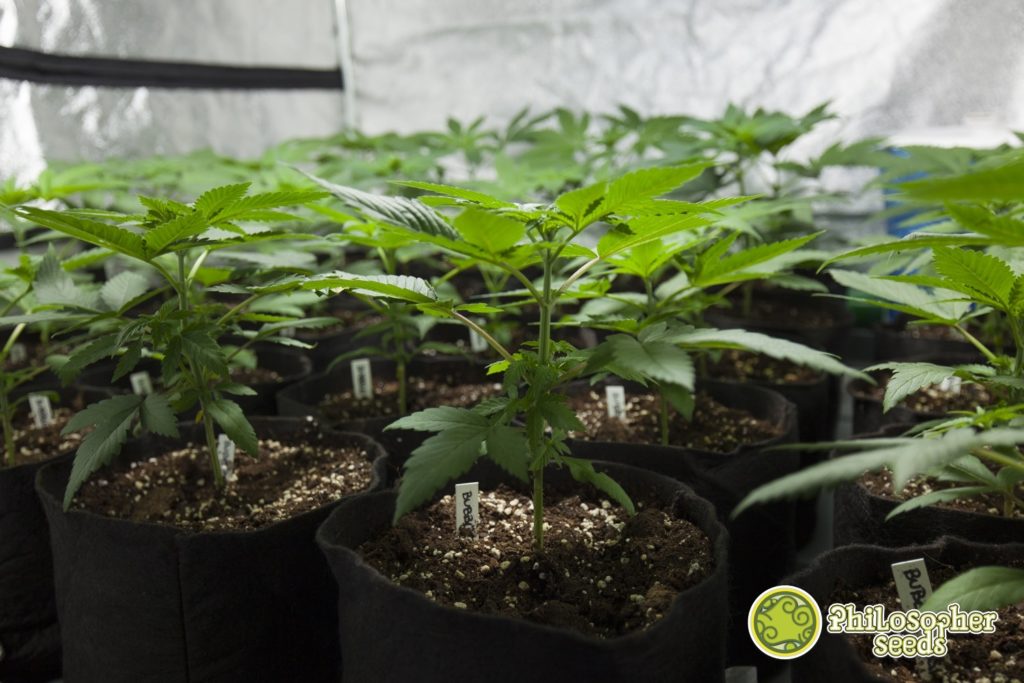
Finally, if we use a hydroponic system to grow, we’ll soon see that it is the most intensive growing medium; This way of cultivating is the one that most accelerates the growth phase, as the oxygenation of the roots is even greater than with coco fibre, and nutrition is usually applied more intensively than in the two previous growing media. However, given the complexity of this system, it is usually reserved for experienced growers.
Cultivation parameters in the growth phase of cannabis
Light
The photoperiod in the vegetative or growth phase of the plant is the lengthiest of the entire cannabis grow in terms of daily light hours. It is recommended to apply a photoperiod of 18 hours of light and 6 of darkness per day, which we can easily adjust with the help of a timer.
Both the hours of light and the hours of darkness are important. During the hours of light the plant performs photosynthesis: through chlorophyll the plant absorbs light and transforms the energy of light into chemical energy, or in other words, transforms inorganic energy into organic energy.
On the other hand, during the hours of darkness, the plant only performs cellular respiration, absorbs oxygen and releases carbon dioxide, a fundamental part of the metabolism of plant cells. The balance between these two processes is essential for the proper development of the plant.
Regarding the type or quality of light for the growth phase, there are several options. We can use metal halide grow lamps of 250, 400 and 600w, low consumption CFL bulbs, mixed lamps, LED panels, the new LEC or CHM lamps, etc. If we are not in a hurry to move the growth process forward, it is best to use 250W CFL (compact fluorescent) energy-saving bulbs, they have a cool white light spectrum, they do not produce heat and they considerably reduce the electricity bill. The same goes for fluorescent tubes, very popular for rooting cuttings or keeping mother plants.
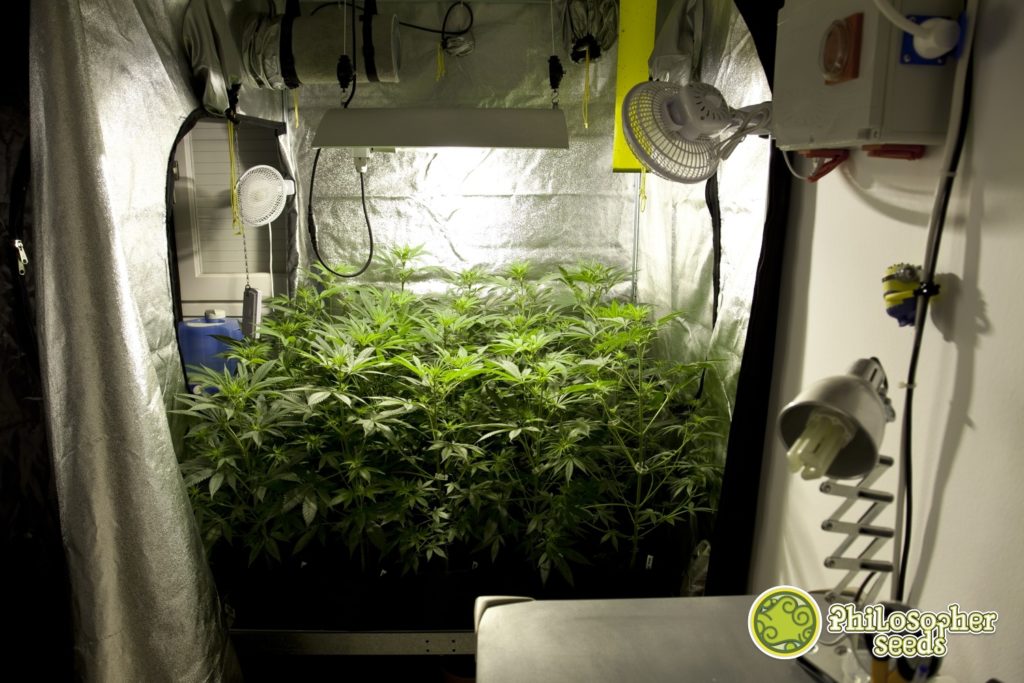
If on the other hand we’re in a hurry and we want to save time in the growth phase, we will use Metal Halide bulbs with white light and of 400-600w. These bulbs - which need an electric ballast to work - accelerate the growth process but produce more heat, which can come in handy if we’re growing in a cold place but could be fatal if the temperature of the room is already high. For this reason, often one type of light is used in winter and another in summer.
There is the option of mixed spectrum HPS bulbs, also 400-600w, which like HM bulbs require an electric ballast to work, are very practical and used by growers around the world. Mixed HPS bulbs combine the light spectrum necessary for the growth and flowering of cannabis plants; using them means we won’t need to change the bulb when we switch to flowering, it’s enough to change the the timer to a photoperiod of 12 hours light and 12 hours darkness.
One fact that should be clear is that the more powerful the lights we’re using, the more heat they will produce. Taking into account the crucial importance of temperature, we will always try to maintain the temperature in our grow at between 22-26ºC when lights are on light, and 18-22ºC in darkness. These temperature ranges will be achieved by installing proper ventilation and extraction equipment, and using heaters or air conditioning if necessary.
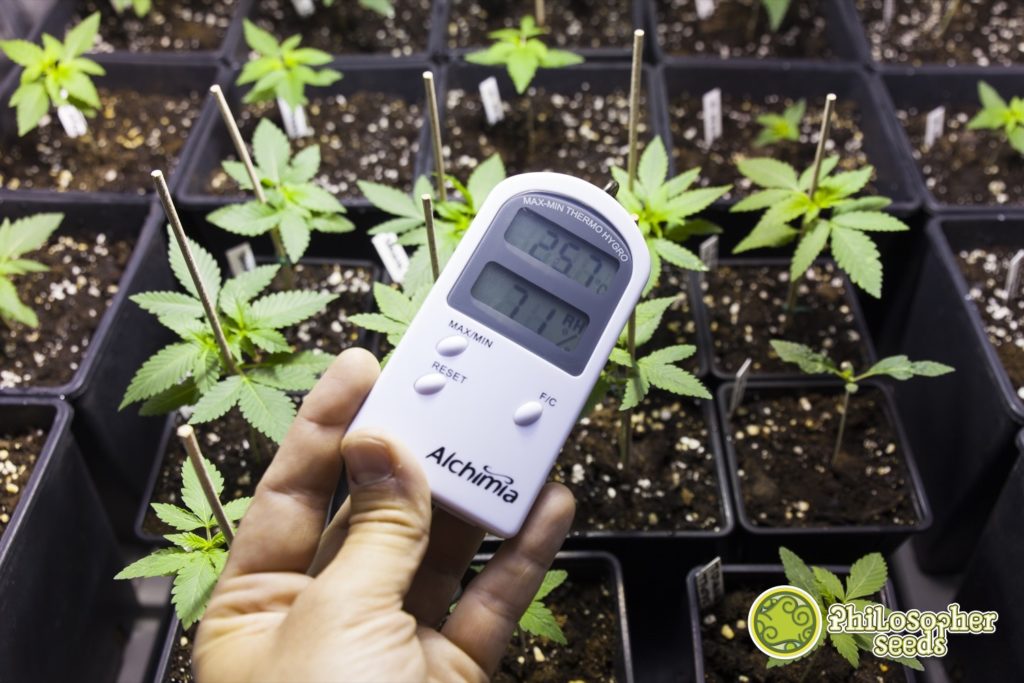
Thus, our lighting system must always be accompanied by good quality extraction and ventilation equipment suited to the size of the grow room and the power and type of lamp we’re using. If the growing environment is very dry, we may also need a humidifier; In the growth phase, it is recommended to maintain relative humidity values of 60% to 70%. In the case of cold areas a small heating radiator can help us to stabilise the temperature. Using an air heater is not recommended since it expels hot air and can dry out the growing environment excessively.
Irrigation
Irrigation in the growth phase follows the exponential rhythm of this period of plant development. We can easily observe how the amount and frequency of irrigation demanded by the plants will increase as the weeks go by and they grow. It is very important to be alert and respond to this growing water demand, especially in crops with coconut fibre. The ideal temperature of the irrigation water should be around 22 degrees. Proper adjustment of the temperature and humidity in our grow cabinet will help maintain a moist and fluffy substrate.
Controlling the pH (the coefficient that indicates the acidity or alkalinity of the water) and the EC (electro-conductivity or level of dissolved salts) of the irrigation water is a factor to take into account, since the effective assimilation of nutrients by the plant depends on it. The recommended pH of irrigation water for a marijuana crop in soil is between 6 and 6.8. The water EC should be around 0.4-1.2 milliSiemens (depending on the type of soil used and the amount of fertiliser it contains). In coconut and hydroponics we will use a lower pH, about 5.5-6 and a somewhat higher EC, between 1.4 and 1.6.
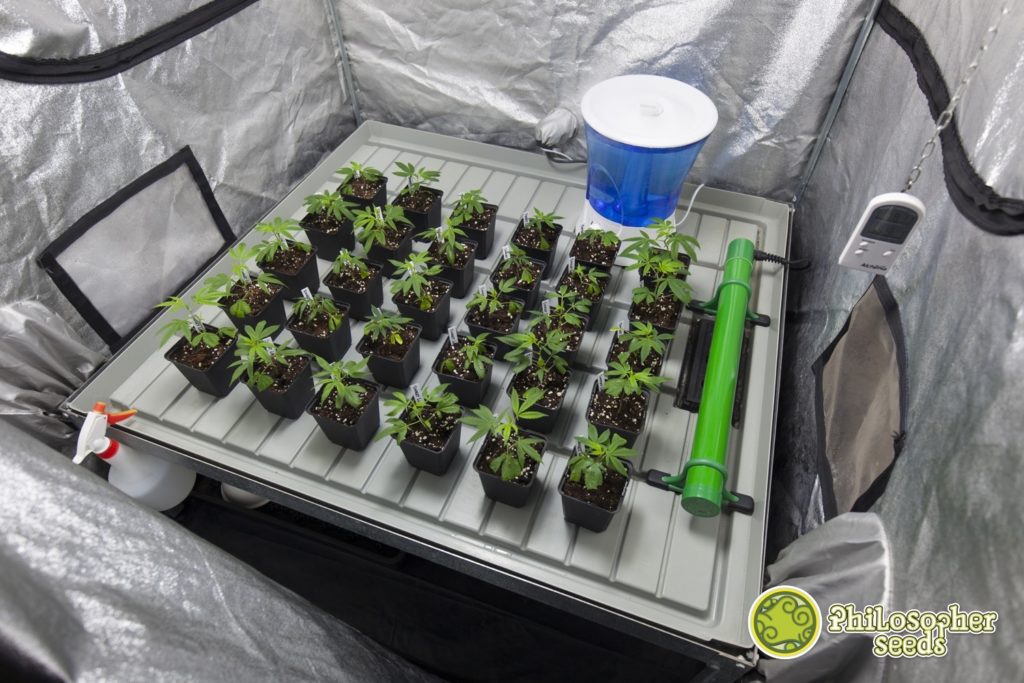
Nutrients
Nutrients are another decisive factor in the growth phase. There is a wide range of options, and a large number of nutritional products and activators for growing cannabis are available on the market. In the vegetative phase primarily Nitrogen (N) and to a lesser extent Potassium (K) are the elements most consumed by the plant.
A very convenient and safe option is to opt for one of the many fertilised substrates available today. These are very complete products with the correct variety of nutrients to cover the needs of the plants for three weeks or a month, a time that in many cases will comfortably cover the vegetative phase. It is highly recommended (especially during the first stage of the growth phase) to apply a root stimulator mixed with the irrigation water, which will give a good boost to the root development of the plants, accelerating the progress of the crop.
We must be very careful with over-fertilisation, it’s all too easy to saturate the plant with the accumulation of salts from the fertilisers, which prevents the plant from assimilating the nutrients correctly. One of the most common deficiencies is nitrogen, easily detectable by the yellowing of the oldest leaves (from the bottom of the plant upwards). Calcium (Ca) and Magnesium (Mg) are also important elements that should never be missing; a deficiency of them affects the younger leaves and buds, which will grow deformed and with yellowish spots.
Summary of the main factors during the vegetative growth period of cannabis
- Given the seasonality of outdoor cultivation, the growth phase can last from 3 to 6 months depending on variety.
- In indoor cultivation we can control factors like the photoperiod, enabling us to “manipulate” natural processes and accelerate development.
- The growth phase of indoor cannabis plants can last from 2 to 4 weeks (autoflowering genetics) and from 4 to 8 weeks (feminised seeds) depending on the variety.
- The growing medium also influences the duration of the growth period: soil (less intensive); coco fibre (medium intensity); and hydroponics (more intensive and complex)
- The photoperiod in the vegetative growth phase of indoor cannabis plants is the longest in term of hours of light, with 18 hours light and 6 hours of darkness recommended.
- Types of lamp for the growth period: Energy saving 250w CFL lightbulbs (slower growth); 400-600w Metal Halide bulbs (explosive growth); 400-600w mixed spectrum HPS and 315w LEC/CMH bulbs (explosive growth & versatility).
- Range of temperature and humidity for the growth period: Temperature between 18-26ºC. Relative humidity from 60-70%.
- The demand for water grows with the development of the plant, so always pay attention to your plants irrigation needs. The ideal temperature of the irrigation water is 22ºC.
- Control the quality of the irrigation water: the recommended pH for water in a cannabis grow is between 6 and 6.8. The EC should be around 0.4-1.2 miliSiemens.
- During the vegetative phase of cannabis plants, principally Nitrogen (N) and Potassium (K) are the most consumed elements.
- A composite substrate that is rich in nutrients or a good mix of solid fertilisers can perfectly cover the nutritional demands of the plants for the entire growth phase.
We hope that this article will help you to get better growth in your crops. Without a doubt, a healthy growth phase is fundamental to achieve explosive flowering and the best possible performance from our plants!
Happy growing!






